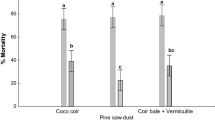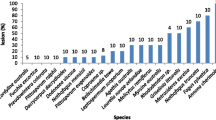Abstract
Alternaria zinniae is a fungal pathogen of weeds in the Noogoora burr complex. The effects of environment on infection and disease development were studied quantitatively by inoculating plants of Xanthium occidentale (Noogoora burr) and Xanthium italicum (Hunter burr) in a spore settling tower and incubating them in environmentally controlled dew chambers. Leaf necrosis was greatest on both plant species after dew periods of 18 h. Forty percent of the maximum leaf necrosis was observed after dew periods of 8 h or longer. Leaf necrosis was greatest when plants were subjected to temperatures of 15–20°C during the dew period and of 25°C after the dew period. Disease resistance was increased by water stress prior to the dew period but was greatly decreased by water stress after the dew period. Given favourable conditions in the field, A. zinniae has potential to control weeds in the Noogoora burr complex.
Similar content being viewed by others
References
Abbas, H.K. and Barrentine, W.L. (1995) — Alternaria helianthi and imazaquin for control of imazaquin susceptible and resistant cocklebur (Xanthium strumarium) biotypes. Weed Science 43: 425–428.
Allen, S.J. (1981) — Alternaria Blight of Sunflowers in Australia. PhD Thesis, Department of Botany, University of New England: Armidale, NSW, Australia.
Auld, B.A., Talbot, H.E. and Radburn, K.B. (1992) — Host range of three isolates of Alternaria zinniae, a potential biocontrol agent for Xanthium spp. Plant Protection Quarterly 7: 114–116.
Boyer, J.S. (1995) — Biochemical and biophysical aspects of water deficits and the predisposition to disease. Annual Review of Phytopathology 33: 251–274.
Boyette, C.D. and Abbas, H.K. (1994) — Host range alteration of the bioherbicidal fungus Alternaria crassa with fruit pectin and plant filtrates. Weed Science 42: 487–491.
Brown, J.F., Clark, D.I. and Kochman, J.K. (1974) — A temperature controlled dew chamber to provide uniform conditions for infection by foliage pathogens. Australasian Plant Pathology Society Newsletter 3: 58.
Brown, J.F. and Fittler, J.F. (1981) — A quantitative method of inoculating plants with uniform densities of fungal spores. Australasian Plant Pathology 10: 51–53.
Carson, M.L. (1987) — Effects of two foliar pathogens on seed yield of sunflower. Plant Disease 71: 549–551.
Combellack, J.H. (1989) — The importance of weeds and the advantages and disadvantages of herbicide use. Plant Protection Quarterly 4: 14–33.
Crump, N. S., Cother, E. J. and Ash, G. J. (1999) — Clarifying the nomenclature in microbial weed control. Biocontrol Science and Technology 9: 89–97.
Day, R.W. and Quinn, G.P. (1989) — Comparisons of treatments after an analysis of variance in ecology. Ecological Monographs 59: 433–463.
Dimock, A.W. and Osborn, J.H. (1943) — An alternaria disease of zinnia. Phytopathology 33: 372–381.
Ellis, M.B. (1976) — More Dematiaceous Hyphomycetes. Commonwealth Mycological Institute: Kew.
Forsberg, J.L. and Crane, J.L. (1970) — A disease of Ageratum, new to the United States. Plant Disease Reporter 54: 1095–1096.
Hocking, P.J. and Liddle, M.J. (1986) — The biology of Australian weeds: 15. Xanthium occidentale Bertol. complex and Xanthium spinosum L. The Journal of the Australian Institute of Agricultural Science 52: 191–221.
McDonald, W.C. and Martens, J.W. (1963) — Leaf and stem spot of sunflowers caused by Alternaria zinniae. Phytopathology 53: 93–96.
McRae, C.M. (1988) — Classical and inundative approaches to biological weed control compared. Plant Protection Quarterly 3: 124–127.
McRae, C.M. (1989) — The feasibility of using Colletotrichunt orbiculave as a mycoherbicide to control Xanthium spinosum (Bathurst burr). PhD Thesis, Department of Botany, University of New England: Armidale, NSW, Australia.
Morin, L., Auld, B.A, and Brown, J.F. (1993) — Interaction between Pucciniaxanthii and facultative parasitic fungi on Xanthium occidentale. Biological Control 3: 288–295.
Morin, L.. Auld, B.A., Brown, J.F. and Cholil. M.A. (1994) — Pathogenic fungi occurring on the Noogoora burr complex in Australia. Proceedings of the Linnaean Society of NSW 114: 133–148.
Nehl, D.B. and Brown, J.F. (1992) — Alternaria zinniae: a candidate for the biocontrol of Xanthium weeds. In Proceedings of the 1st International Weed Control Congress, pp. 356–358. Weed Science Society of Victoria Inc., Melbourne, Australia.
Pape, H. (1942) — Die Alternaria-krankheit der Zinnie und ihre bekampfung. (Alternaria zinniae n. sp.). Angewandte Botanik 24: 61–79.
Parbery, D.G. (1996) — Trophism and the ecology of fungi associated with plants. Biological Reviews 71: 473–527.
Quimby, P.C. (1989) — Response of common cocklebur (Xanthium strumarium) to Alternaria helianthi. Weed Technology 3: 177–181.
Simmonds, J.H. (1966) — Host Index of Plant Diseases in Queensland. Queensland Department of Primary Industries: Brisbane.
Snipes, C.E., Street, J.E. and Walker, R.H. (1987) — Interference periods of common cocklebur (Xanthium strumarium) with cotton (Gossypium hirsutum). Weed Science 35: 529–532.
SYSTAT (1992) — Statistics, Version 5.2 Edition. Systat Inc.: Evanston, USA.
Watson, A.K. (1985) — Host specificity of plant pathogens in biological weed control. In Proceedings of the Sixth International Symposium on the Biological Control of Weeds (Ed E. S. Delfosse), pp. 577–586. Canada Agriculture: Vancouver.
Yang, S.-M. (1994) — Control of Carduus acanthoides with Myrothecium verrucaria in the greenhouse in the absence of dew. Phytopathology 84: 1136.
Author information
Authors and Affiliations
Rights and permissions
About this article
Cite this article
Nehl, D.B., Brown, J.F. Biological control of the Noogoora burr complex with Alternnria zinniae: environmental conditions favouring disease. Australasian Plant Pathology 29, 71–80 (2000). https://doi.org/10.1071/AP00014
Received:
Accepted:
Issue Date:
DOI: https://doi.org/10.1071/AP00014




